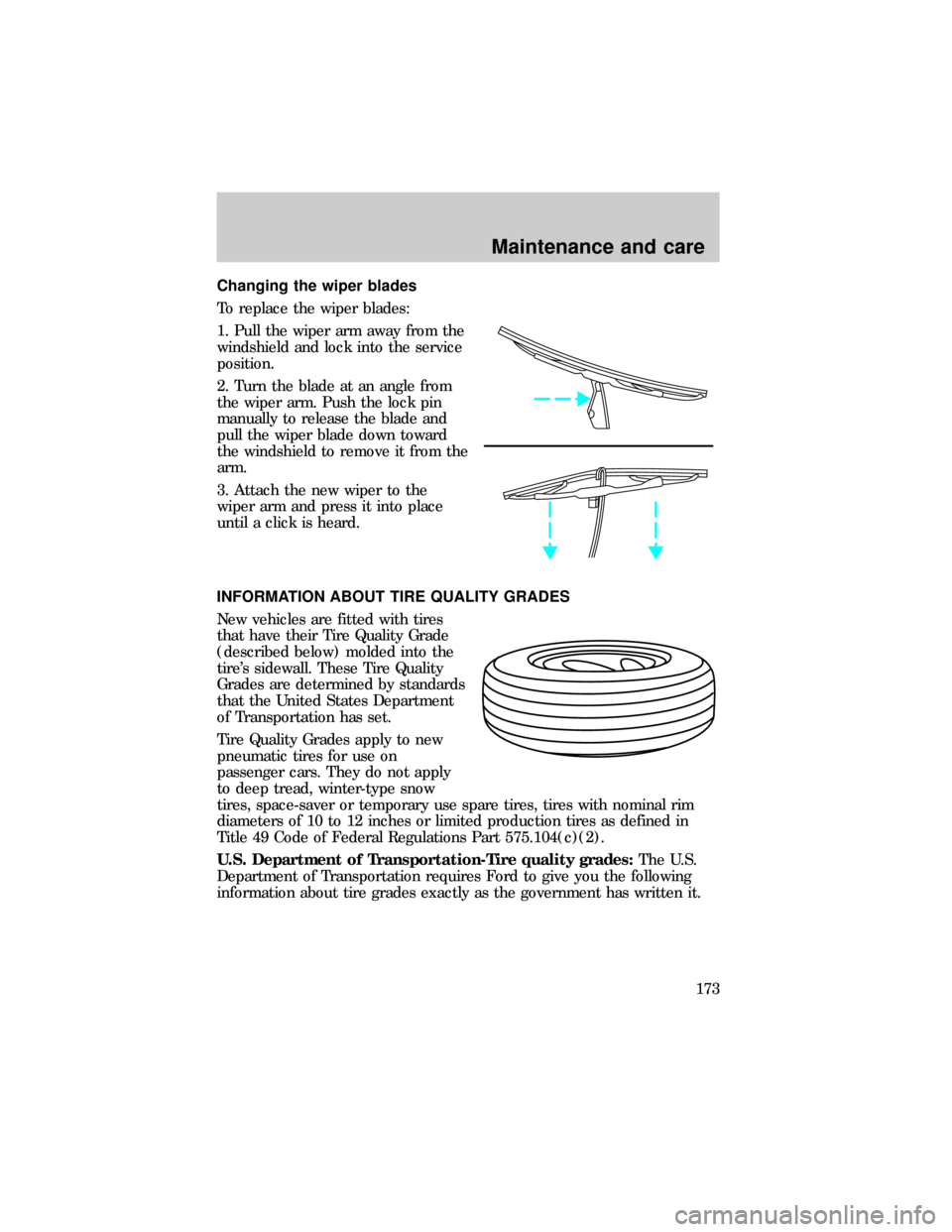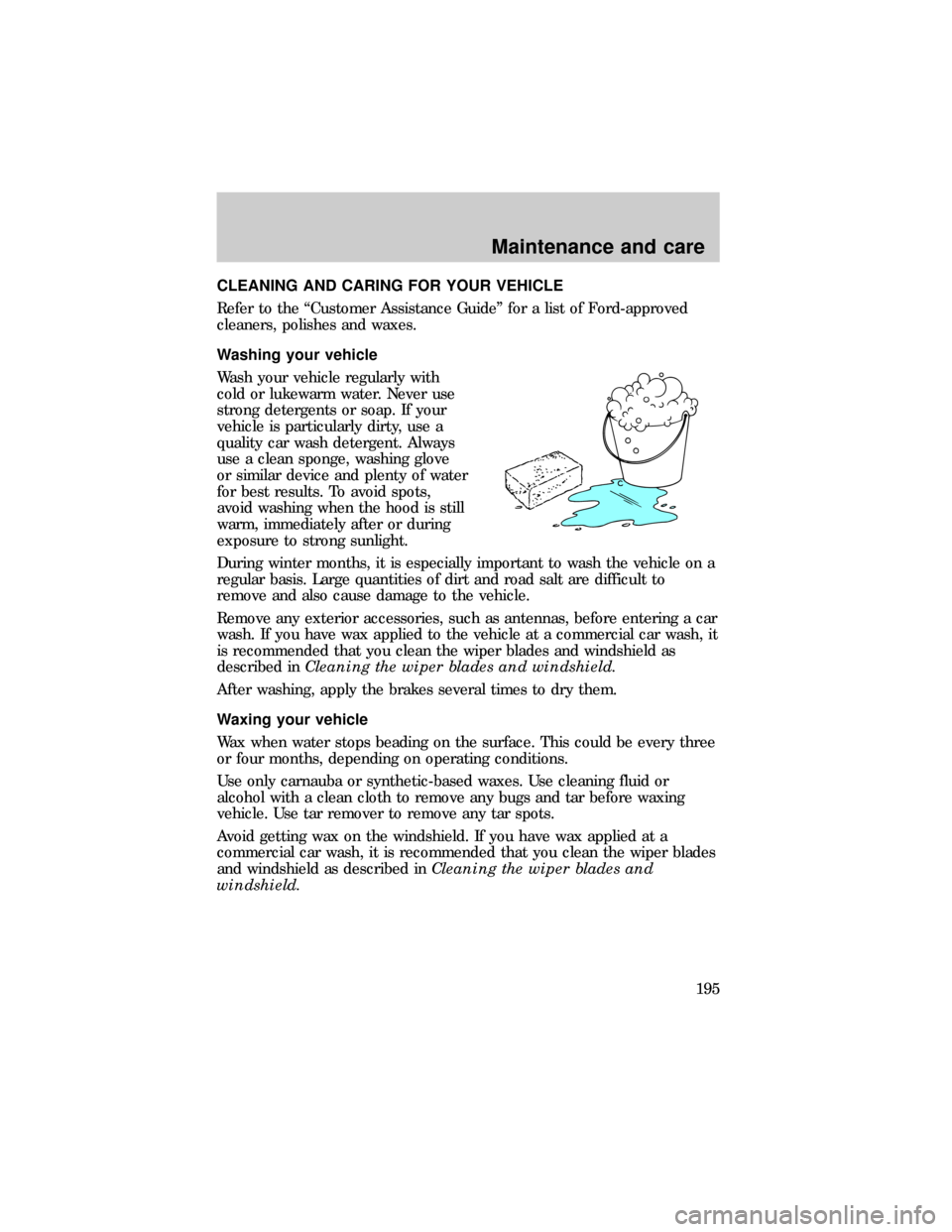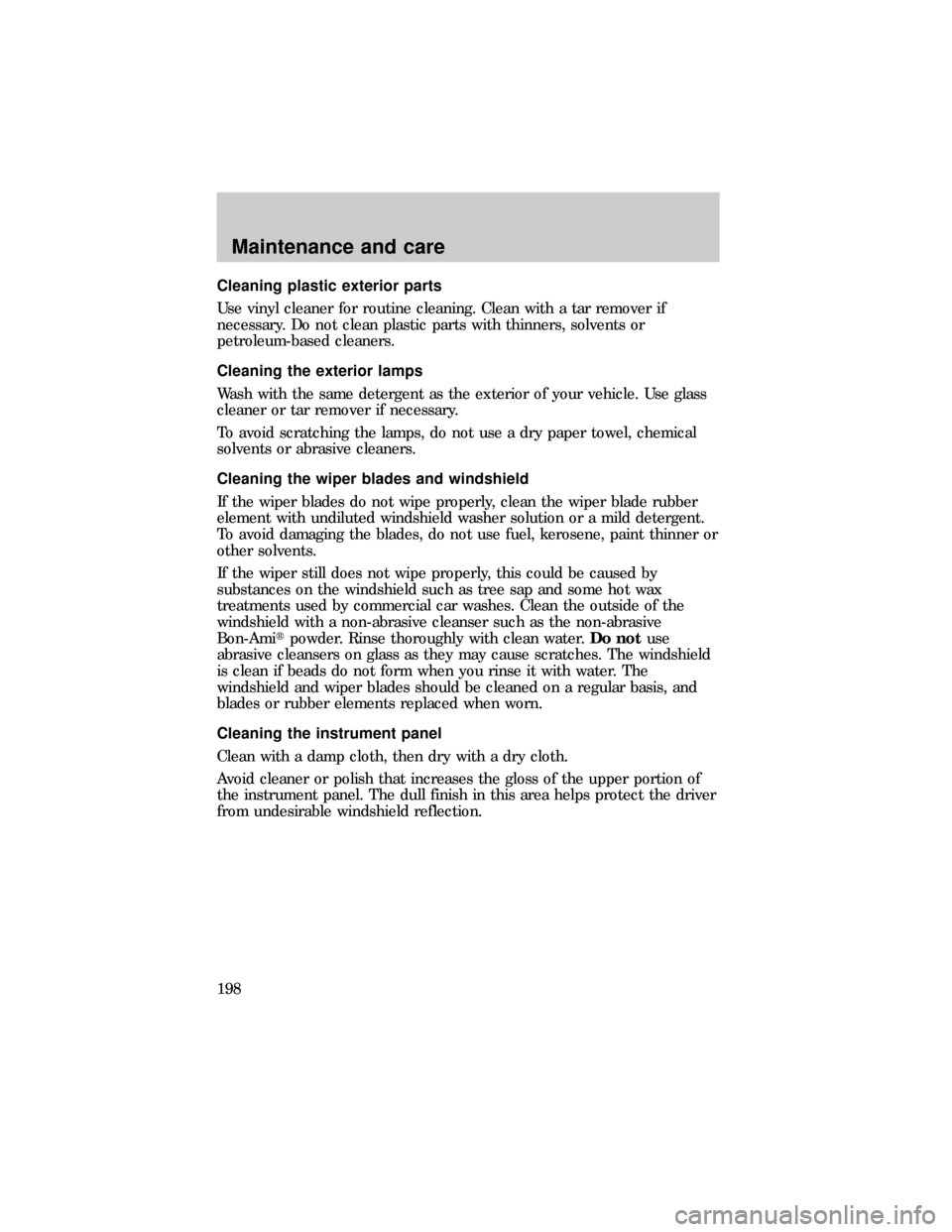1999 FORD RANGER wiper blades
[x] Cancel search: wiper bladesPage 172 of 216

If the battery has been disconnected or a new battery has been installed,
the clock and the preset radio stations must be reset once the battery is
reconnected.
²Always dispose of automotive
batteries in a responsible manner.
Follow your local authorized
standards for disposal. Call your
local authorized recycling center
to find out more about recycling
automotive batteries.
WINDSHIELD WIPER BLADES
Check the wiper blades at least twice a year or when they seem less
effective. Substances such as tree sap and some hot wax treatments used
by commercial car washes reduce the effectiveness of wiper blades.
Checking the wiper blades
If the wiper blades do not wipe properly, clean both the windshield and
wiper blades using undiluted windshield wiper solution or a mild
detergent. Rinse thoroughly with clean water. To avoid damaging the
blades, do not use fuel, kerosene, paint thinner or other solvents.
LEAD
RETURN
RECYCLE
Maintenance and care
172
Page 173 of 216

Changing the wiper blades
To replace the wiper blades:
1. Pull the wiper arm away from the
windshield and lock into the service
position.
2. Turn the blade at an angle from
the wiper arm. Push the lock pin
manually to release the blade and
pull the wiper blade down toward
the windshield to remove it from the
arm.
3. Attach the new wiper to the
wiper arm and press it into place
until a click is heard.
INFORMATION ABOUT TIRE QUALITY GRADES
New vehicles are fitted with tires
that have their Tire Quality Grade
(described below) molded into the
tire's sidewall. These Tire Quality
Grades are determined by standards
that the United States Department
of Transportation has set.
Tire Quality Grades apply to new
pneumatic tires for use on
passenger cars. They do not apply
to deep tread, winter-type snow
tires, space-saver or temporary use spare tires, tires with nominal rim
diameters of 10 to 12 inches or limited production tires as defined in
Title 49 Code of Federal Regulations Part 575.104(c)(2).
U.S. Department of Transportation-Tire quality grades:The U.S.
Department of Transportation requires Ford to give you the following
information about tire grades exactly as the government has written it.
Maintenance and care
173
Page 195 of 216

CLEANING AND CARING FOR YOUR VEHICLE
Refer to the ªCustomer Assistance Guideº for a list of Ford-approved
cleaners, polishes and waxes.
Washing your vehicle
Wash your vehicle regularly with
cold or lukewarm water. Never use
strong detergents or soap. If your
vehicle is particularly dirty, use a
quality car wash detergent. Always
use a clean sponge, washing glove
or similar device and plenty of water
for best results. To avoid spots,
avoid washing when the hood is still
warm, immediately after or during
exposure to strong sunlight.
During winter months, it is especially important to wash the vehicle on a
regular basis. Large quantities of dirt and road salt are difficult to
remove and also cause damage to the vehicle.
Remove any exterior accessories, such as antennas, before entering a car
wash. If you have wax applied to the vehicle at a commercial car wash, it
is recommended that you clean the wiper blades and windshield as
described inCleaning the wiper blades and windshield.
After washing, apply the brakes several times to dry them.
Waxing your vehicle
Wax when water stops beading on the surface. This could be every three
or four months, depending on operating conditions.
Use only carnauba or synthetic-based waxes. Use cleaning fluid or
alcohol with a clean cloth to remove any bugs and tar before waxing
vehicle. Use tar remover to remove any tar spots.
Avoid getting wax on the windshield. If you have wax applied at a
commercial car wash, it is recommended that you clean the wiper blades
and windshield as described inCleaning the wiper blades and
windshield.
Maintenance and care
195
Page 198 of 216

Cleaning plastic exterior parts
Use vinyl cleaner for routine cleaning. Clean with a tar remover if
necessary. Do not clean plastic parts with thinners, solvents or
petroleum-based cleaners.
Cleaning the exterior lamps
Wash with the same detergent as the exterior of your vehicle. Use glass
cleaner or tar remover if necessary.
To avoid scratching the lamps, do not use a dry paper towel, chemical
solvents or abrasive cleaners.
Cleaning the wiper blades and windshield
If the wiper blades do not wipe properly, clean the wiper blade rubber
element with undiluted windshield washer solution or a mild detergent.
To avoid damaging the blades, do not use fuel, kerosene, paint thinner or
other solvents.
If the wiper still does not wipe properly, this could be caused by
substances on the windshield such as tree sap and some hot wax
treatments used by commercial car washes. Clean the outside of the
windshield with a non-abrasive cleanser such as the non-abrasive
Bon-Amitpowder. Rinse thoroughly with clean water.Do notuse
abrasive cleansers on glass as they may cause scratches. The windshield
is clean if beads do not form when you rinse it with water. The
windshield and wiper blades should be cleaned on a regular basis, and
blades or rubber elements replaced when worn.
Cleaning the instrument panel
Clean with a damp cloth, then dry with a dry cloth.
Avoid cleaner or polish that increases the gloss of the upper portion of
the instrument panel. The dull finish in this area helps protect the driver
from undesirable windshield reflection.
Maintenance and care
198
Page 210 of 216

Air bag supplemental restraint
system ..........................................81
and child safety seats ..............83
description ................................82
disposal ......................................85
indicator light ...........................85
passenger air bag .....................83
passenger deactivation
switch ....................23,86,87,88,89
Air conditioning
manual heating and air
conditioning system .......19,20,21
Automatic transmission
driving an automatic
overdrive .....108,109,110,111,112
Axle
refill capacities ........................200
Battery
voltage gauge ............................15
Brakes ........................................103
anti-lock .....................103,104,105
anti-lock brake system (ABS)
warning light ...........................104
fluid, checking and adding ....160
shift interlock ..........................107
Break-in period ..........................2,3
Cargo area shade ........................64
Cargo net .....................................64
CD player ....................................51
Child safety seats
attaching with tether straps ....96
in rear seat ................................93
tether anchorage hardware .....96
Cleaning your vehicle ...............195
engine compartment ..............196
exterior .............................196,199
exterior lamps .........................198
interior .....................................199
plastic parts ............................198
washing ....................................195
waxing .....................................195
wheels ......................................196windows ..................................199
wiper blades ............................198
Clutch
fluid ..........................................161
operation while driving ...112,113
recommended shift speeds ....114
Console ........................................64
Coolant ...............................164,165
checking and adding ..............163
refill capacities ........................165
Driveline universal joint and
slip yoke ....................................169
Driving under special
conditions ...........................118,119
sand .........................................119
snow and ice ...........................120
through water .........................119
Emission control system ..........186
Engine
check engine/service engine
soon light .................................6,7
coolant .....................................162
idle speed control ...................170
service points ............154,155,156
starting after a collision .........133
Engine block heater .................100
Engine oil
checking and adding ..............158
dipstick ....................................157
specifications ...................157,159
Exhaust fumes ..........................102
Four-Wheel Drive vehicles ..10,115
description .......................116,117
driving off road .......................118
electronic shift ..............22,23,116
indicator light .........................115
Fuel
choosing the right fuel ...........180
comparisons with EPA fuel
economy estimates .................186
detergent in fuel .....................182
Index
210
Page 212 of 216

locking/unlocking doors ...........65
replacement/additional
transmitters ...............................67
replacing the batteries .............66
Safety belts (see Safety
restraints) ....................................11
Safety restraints
cleaning the safety belts ...81,199
extension assembly ..................80
for children ..........................90,91
lap belt .................................78,79
warning light and chime .....11,80
Seat belts (see Safety
restraints) ................73,74,75,76,77
Seats ............................................71
child safety seats ......................92
Servicing your vehicle .......152,153
Snowplowing .................................3
Spark plugs, specifications .......200
Special notice ................................3
ambulance conversions ..............3
utility-type vehicles ....................3
Specification chart, lubricants .202
Speed control ..............................56
Speedometer ...............................14
Starting your vehicle ......97,98,100
jump starting ............146,147,149
Steering wheel
tilting .........................................61
Tachometer .................................13
Tires .............................173,174,175
changing .............141,142,143,144
checking the pressure ............175replacing ..................................176
rotating ....................................175
snow tires and chains ............177
tire grades ...............................174
treadwear ................................174
Towing
recreational towing ..........130,131
wrecker ....................................151
Traction-lok rear axle ...............120
Transfer case
fluid checking .........................169
Transmission ......................107,166
fluid, checking and adding
(automatic) ......................166,167
fluid, checking and adding
(manual) .................................168
manual operation ....................112
Trip odometer .............................14
Vehicle dimensions ...................205
Vehicle Identification Number
(VIN) ..........................................208
Vehicle loading ..........................121
camper bodies ........................132
Ventilating your vehicle ...........102
Warning chimes .............................6
Washer fluid ..............................162
Water, Driving through .............121
Windows .................................62,63
Windshield washer fluid and
wipers
checking and cleaning ............172
operation ...................................62
replacing wiper blades ...........173
Index
212